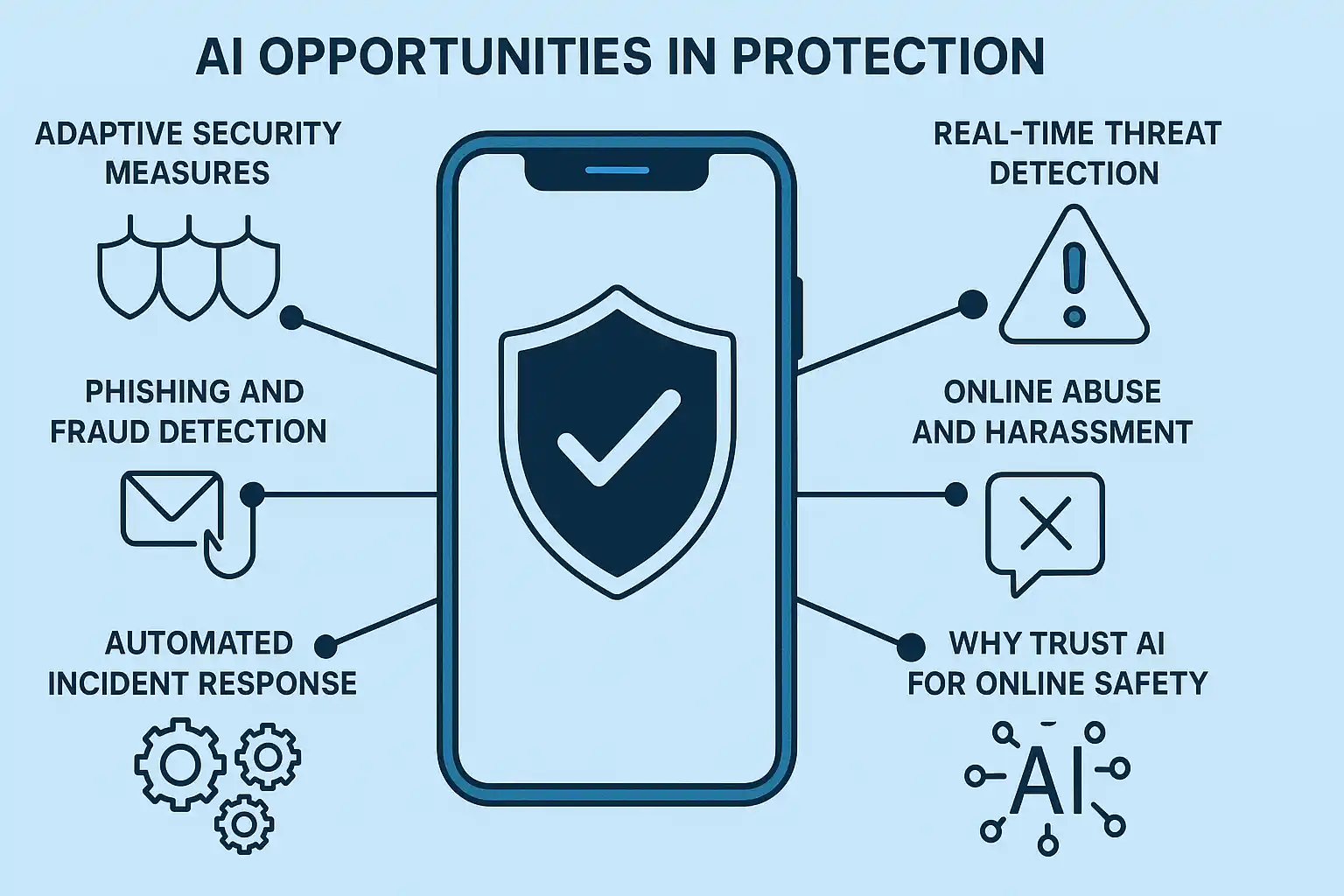The Internet today is a space for work, socialization, and storing data for billions of people, but is it safe enough to keep all of that? Cyber threats are now more sophisticated and hard to detect than before, and traditional security methods often lack power to protect users.
Artificial intelligence provides an alternative to traditional online security measures, offering smarter, faster, and more adaptive protection. It goes beyond traditional systems, providing real-time detection and prevention, abilities to track this phone number and to detect frauds before they harm you. Here we’ll explore five key ways AI improves online safety now. It is much more than just a tool for fun, but a serious instrument for defence — so learn how it works!

Adaptive Security Measures
Traditional security systems are based on predefined rules and signatures that only work against known threats. However, as cybercriminals continuously change their tactics, these static defenses often fail to protect against new forms of attacks.
How AI enhances security:
- Dynamic Protection: AI learns from its environment and adapts in real-time. It detects new threats based on emerging patterns, providing continuous protection.
- Real-Time Adjustments: AI can automatically adjust security measures (e.g., blocking unauthorized access or requiring additional verification) as soon as an anomaly is detected.
- Proactive Defense: AI anticipates potential threats by analyzing large datasets, staying one step ahead of cybercriminals.
AI-driven apps, like Number Tracker, use adaptive security measures to ensure user information remains protected, even as new threats arise. They help to protect some of the least protected categories of users, including children and teens. With NumberTracker, parents can stay safe about their children’s behaviour online. Malicious website doesn’t have to be blacklisted — a smart system will detect it on its own and prevent viruses and leaks of personal data.

Real-Time Threat Detection and Prevention
Speed is essential when it comes to online security. Delays in detecting and responding to threats can lead to devastating consequences, especially for financial and personal data. AI is capable of real-time monitoring and rapid response, ensuring immediate protection.
How AI helps in threat detection:
- Continuous Monitoring: AI systems track online activities 24/7, analyzing data to spot any unusual or suspicious behavior.
- Instant Response: Once a threat is detected (e.g., an unauthorized login or abnormal transaction), AI systems can take immediate action, such as blocking access or alerting users.
- Learning Over Time: As AI processes more data, it becomes more accurate in identifying potential threats, reducing false positives and improving detection capabilities.
With AI-powered real-time threat detection, users can rest assured that their information is constantly under protection, even as new threats emerge.
Enhanced Phishing and Fraud Detection
Phishing attacks are one of the most common ways cybercriminals trick people into revealing sensitive information. AI plays a crucial role in detecting phishing attempts by analyzing emails, URLs, and attachments for signs of fraud.
How AI combats phishing:
- Pattern Recognition: AI uses machine learning to identify phishing patterns, flagging suspicious content such as fake email addresses or malicious links.
- Continuous Improvement: AI systems learn from past phishing attacks, becoming more effective at detecting even the most sophisticated scams.
- Instant Action: When a phishing attempt is detected, AI can block the harmful content and notify the user in real-time, preventing them from falling victim to the scam.
Analyzing and detecting phishing attacks with AI allows users to keep safe from fraud, especially in online banking and email, where such attacks sometimes become massive.
Fighting Abuse and Harassment Online
While online spaces are perfect for connecting people, they also include platforms where abuse, harassment, and scams thrive. They harm not just adults, but specifically children and teens in their online-spots. AI plays a critical role in this field by providing tools that detect and mitigate abusive behavior.
How AI helps in online safety:
- Real-Time Content Moderation: AI systems automatically analyze and flag harmful content, such as offensive language, bullying, or hate speech. They constantly adapt to new forms of dangerous behaviour and make online spaces safer every day.
- Identifying Patterns of Abuse: AI detects recurring patterns of behavior that indicate harassment, such as repeated targeted messages or offensive posts and typical words in them. By recognizing these patterns, AI takes can block accounts or limit their ability to interact with others.
- Enforcing Community Guidelines: AI enforces community guidelines by automatically removing harmful content, flagging accounts for review, or alerting moderators to potential violations. This reduces the need for manual oversight and creates safer spaces for users.
AI-based safety programs are already applied on Facebook, Instagram, and Twitter. With machine learning and natural language processing, they identify harmful content quite accurately, ensuring a safer experience for all users. There is still space for manual work and check ups, but these algorithms minimize the most monotonous parts of work.
And with specified protection tools, such as NumberTracker, parents can prevent their children from getting harmed online. At the same time, instruments like this one provide protection without being intrusive or crossing personnel borders. They just provide a strong shield that simplifies everyday online interactions.
Automated Incident Response and Forensics
When a cyber-attack occurs, the speed and accuracy of the response can make all the difference. With AI, cybersecurity teams respond to incidents quickly and efficiently without too much effort put in incident management.
How AI streamlines incident response:
- Automated Analysis: AI systems automatically analyze data from security events, determining the severity of the threat and identifying the attacker’s source. This reduces the time required for cybersecurity teams to assess and respond to an incident.
- Prioritizing Alerts: AI assesses the urgency of multiple threats simultaneously, ensuring that the most critical issues are addressed first. By doing so, AI helps teams focus on the most significant risks without getting overwhelmed by less urgent problems.
- Autonomous Action: In some cases, AI takes autonomous actions to prevent further damage. For example, it isolates a compromised system, blocks malicious IP addresses, or revokes user access, all without human intervention. This minimizes the impact of an attack while the security team works on a more in-depth solution.
Automated incident response based on AI speeds up threat containment and allows cybersecurity teams to focus on more complex tasks. While they are not focusing on too monotonous tasks, the overall security posture becomes more efficient. Instead, professionals focus on more unusual tasks and improve the whole protective system.
Why Do We Trust Online Safety to Machines?
With all cases mentioned before you see that the massive rise of AI in cybersecurity is no accident. It processes big data quickly, recognizes complex patterns, and acts autonomously in simple cases. As a result, professionals get more free time for unusual tasks that require new human-based solutions, and our general online protection improves as a result.
Key reasons to trust AI in online safety:
- Scalability: AI can handle large volumes of data and monitor numerous activities at once, something traditional systems can’t manage as efficiently.
- Constant Learning: AI improves over time as it processes more data, becoming better at recognizing and responding to emerging threats.
- Speed: With AI working 24/7, threats are detected and neutralized in real time, reducing the window of vulnerability.
Integration of AI into security systems provides stronger protection both for individuals and organizations. Now we don’t need a new hand-written solution to masses of similar viruses — a program can do it autonomously.
You can improve your online safety with AI yourself. You can not just rely on regular algorithms but install some programs yourself. There are multifunctional tools like NumberTracker that focus on protecting children and creating a safer online experience for less protected ones.
Keep following us for more news in tech development and AI inventions!
